Management and Organization Report: Travelodge Case Study Analysis
VerifiedAdded on 2023/04/20
|12
|2320
|361
Report
AI Summary
This report examines Travelodge's management and organizational structure, focusing on the relationship between functional management, the business environment, and strategic objectives. It begins with an introduction to Travelodge, a UK-based hotel chain, and its history. The report then delves into the organizational structure, specifically the matrix structure, and proposes a functional organizational structure for improved communication and employee security. Modern management approaches, particularly the contingency approach, are discussed in the context of Travelodge. The report also explores strategic management, including the application of Porter's 5 forces to analyze the industry and identify innovative strategic objectives. The analysis covers competitive rivalry, supplier and customer power, threats of new entrants and substitutes, and concludes by summarizing the key findings and implications for Travelodge's growth and development.

Running head: MANAGEMENT AND ORGANIZATION
ID number:
Subject: Oil and Gas Management
Topic: Management and Organization
ID number:
Subject: Oil and Gas Management
Topic: Management and Organization
Paraphrase This Document
Need a fresh take? Get an instant paraphrase of this document with our AI Paraphraser
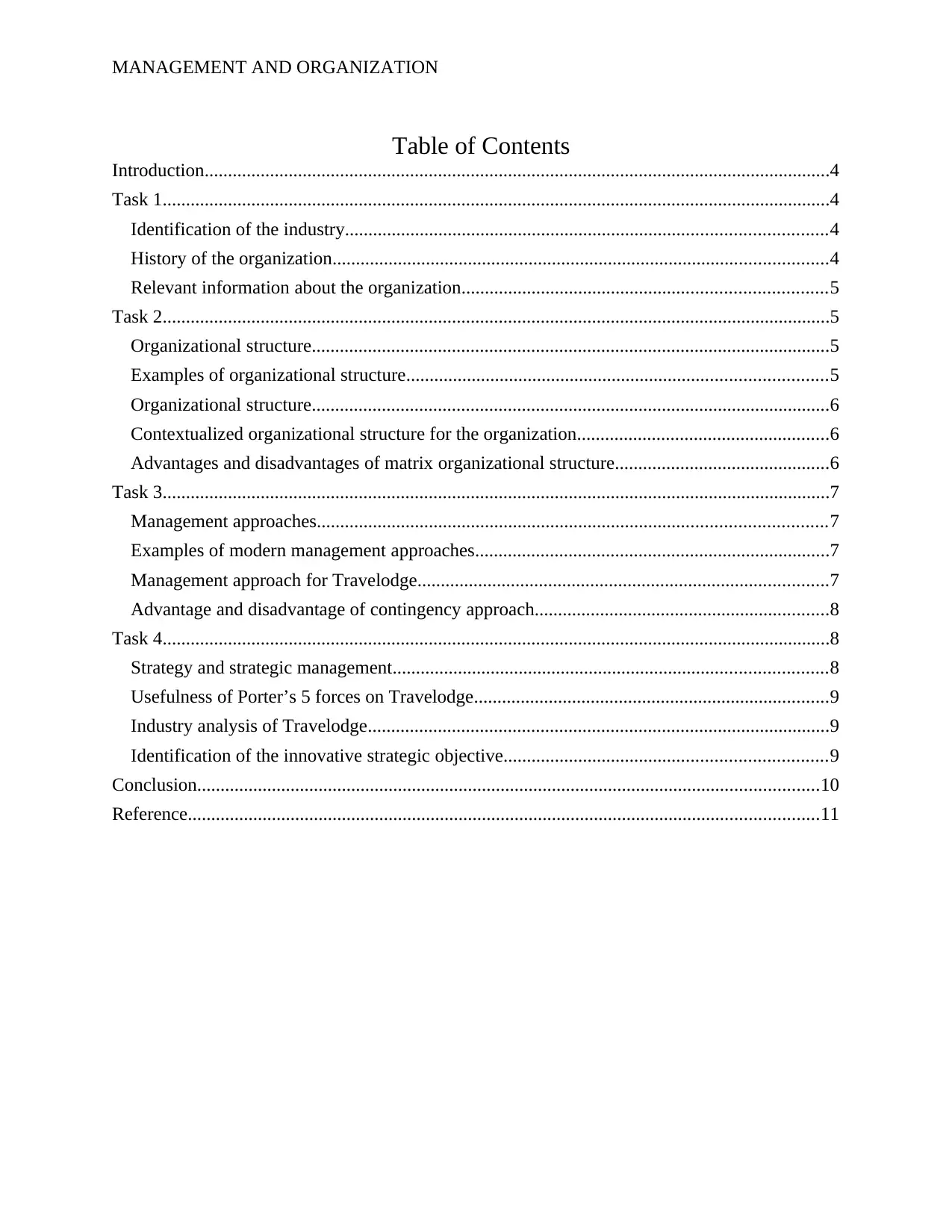
MANAGEMENT AND ORGANIZATION
Table of Contents
Introduction......................................................................................................................................4
Task 1...............................................................................................................................................4
Identification of the industry.......................................................................................................4
History of the organization..........................................................................................................4
Relevant information about the organization..............................................................................5
Task 2...............................................................................................................................................5
Organizational structure...............................................................................................................5
Examples of organizational structure..........................................................................................5
Organizational structure...............................................................................................................6
Contextualized organizational structure for the organization......................................................6
Advantages and disadvantages of matrix organizational structure..............................................6
Task 3...............................................................................................................................................7
Management approaches.............................................................................................................7
Examples of modern management approaches............................................................................7
Management approach for Travelodge........................................................................................7
Advantage and disadvantage of contingency approach...............................................................8
Task 4...............................................................................................................................................8
Strategy and strategic management.............................................................................................8
Usefulness of Porter’s 5 forces on Travelodge............................................................................9
Industry analysis of Travelodge...................................................................................................9
Identification of the innovative strategic objective.....................................................................9
Conclusion.....................................................................................................................................10
Reference.......................................................................................................................................11
Table of Contents
Introduction......................................................................................................................................4
Task 1...............................................................................................................................................4
Identification of the industry.......................................................................................................4
History of the organization..........................................................................................................4
Relevant information about the organization..............................................................................5
Task 2...............................................................................................................................................5
Organizational structure...............................................................................................................5
Examples of organizational structure..........................................................................................5
Organizational structure...............................................................................................................6
Contextualized organizational structure for the organization......................................................6
Advantages and disadvantages of matrix organizational structure..............................................6
Task 3...............................................................................................................................................7
Management approaches.............................................................................................................7
Examples of modern management approaches............................................................................7
Management approach for Travelodge........................................................................................7
Advantage and disadvantage of contingency approach...............................................................8
Task 4...............................................................................................................................................8
Strategy and strategic management.............................................................................................8
Usefulness of Porter’s 5 forces on Travelodge............................................................................9
Industry analysis of Travelodge...................................................................................................9
Identification of the innovative strategic objective.....................................................................9
Conclusion.....................................................................................................................................10
Reference.......................................................................................................................................11
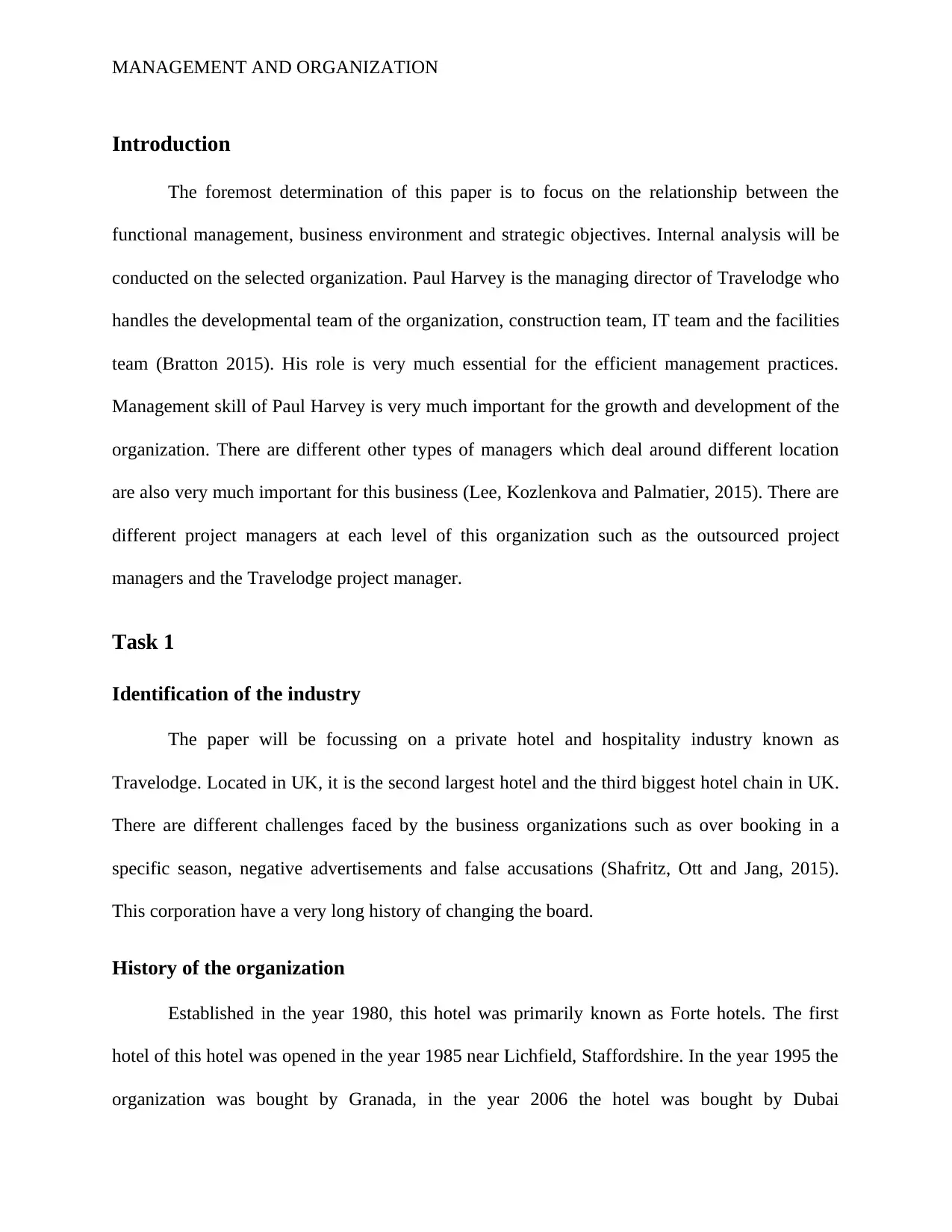
MANAGEMENT AND ORGANIZATION
Introduction
The foremost determination of this paper is to focus on the relationship between the
functional management, business environment and strategic objectives. Internal analysis will be
conducted on the selected organization. Paul Harvey is the managing director of Travelodge who
handles the developmental team of the organization, construction team, IT team and the facilities
team (Bratton 2015). His role is very much essential for the efficient management practices.
Management skill of Paul Harvey is very much important for the growth and development of the
organization. There are different other types of managers which deal around different location
are also very much important for this business (Lee, Kozlenkova and Palmatier, 2015). There are
different project managers at each level of this organization such as the outsourced project
managers and the Travelodge project manager.
Task 1
Identification of the industry
The paper will be focussing on a private hotel and hospitality industry known as
Travelodge. Located in UK, it is the second largest hotel and the third biggest hotel chain in UK.
There are different challenges faced by the business organizations such as over booking in a
specific season, negative advertisements and false accusations (Shafritz, Ott and Jang, 2015).
This corporation have a very long history of changing the board.
History of the organization
Established in the year 1980, this hotel was primarily known as Forte hotels. The first
hotel of this hotel was opened in the year 1985 near Lichfield, Staffordshire. In the year 1995 the
organization was bought by Granada, in the year 2006 the hotel was bought by Dubai
Introduction
The foremost determination of this paper is to focus on the relationship between the
functional management, business environment and strategic objectives. Internal analysis will be
conducted on the selected organization. Paul Harvey is the managing director of Travelodge who
handles the developmental team of the organization, construction team, IT team and the facilities
team (Bratton 2015). His role is very much essential for the efficient management practices.
Management skill of Paul Harvey is very much important for the growth and development of the
organization. There are different other types of managers which deal around different location
are also very much important for this business (Lee, Kozlenkova and Palmatier, 2015). There are
different project managers at each level of this organization such as the outsourced project
managers and the Travelodge project manager.
Task 1
Identification of the industry
The paper will be focussing on a private hotel and hospitality industry known as
Travelodge. Located in UK, it is the second largest hotel and the third biggest hotel chain in UK.
There are different challenges faced by the business organizations such as over booking in a
specific season, negative advertisements and false accusations (Shafritz, Ott and Jang, 2015).
This corporation have a very long history of changing the board.
History of the organization
Established in the year 1980, this hotel was primarily known as Forte hotels. The first
hotel of this hotel was opened in the year 1985 near Lichfield, Staffordshire. In the year 1995 the
organization was bought by Granada, in the year 2006 the hotel was bought by Dubai
⊘ This is a preview!⊘
Do you want full access?
Subscribe today to unlock all pages.

Trusted by 1+ million students worldwide

MANAGEMENT AND ORGANIZATION
International Capital. Financial restructuring was done in the year 2012 (Stokes et al. 2016). By
the end of the year 2010 there were around 32600 bedrooms of this organization all over the
world.
Relevant information about the organization
The rooms of this hotel can also be customized according to the needs and requirement of
the clients. The current parent body of this business organization is Endell Group Holdings
Limited. This business organization growth has shown tremendous over the years.
Task 2
Organizational structure
It is defined as the type of structure in a system where the different types of activities are
managed. These kinds of activities include the rules, responsibilities and responsibilities
(Ashkenas et al. 2015).
Examples of organizational structure
There are different types of organizational structures such as the matrix structure, flat
structure, tall structure, divisional structure, administrative structure.
Figure 1: Different types of organizational structures
Matrix
structure Flat structure
Divisional
structure
Tall structure
Administrative
structure
International Capital. Financial restructuring was done in the year 2012 (Stokes et al. 2016). By
the end of the year 2010 there were around 32600 bedrooms of this organization all over the
world.
Relevant information about the organization
The rooms of this hotel can also be customized according to the needs and requirement of
the clients. The current parent body of this business organization is Endell Group Holdings
Limited. This business organization growth has shown tremendous over the years.
Task 2
Organizational structure
It is defined as the type of structure in a system where the different types of activities are
managed. These kinds of activities include the rules, responsibilities and responsibilities
(Ashkenas et al. 2015).
Examples of organizational structure
There are different types of organizational structures such as the matrix structure, flat
structure, tall structure, divisional structure, administrative structure.
Figure 1: Different types of organizational structures
Matrix
structure Flat structure
Divisional
structure
Tall structure
Administrative
structure
Paraphrase This Document
Need a fresh take? Get an instant paraphrase of this document with our AI Paraphraser
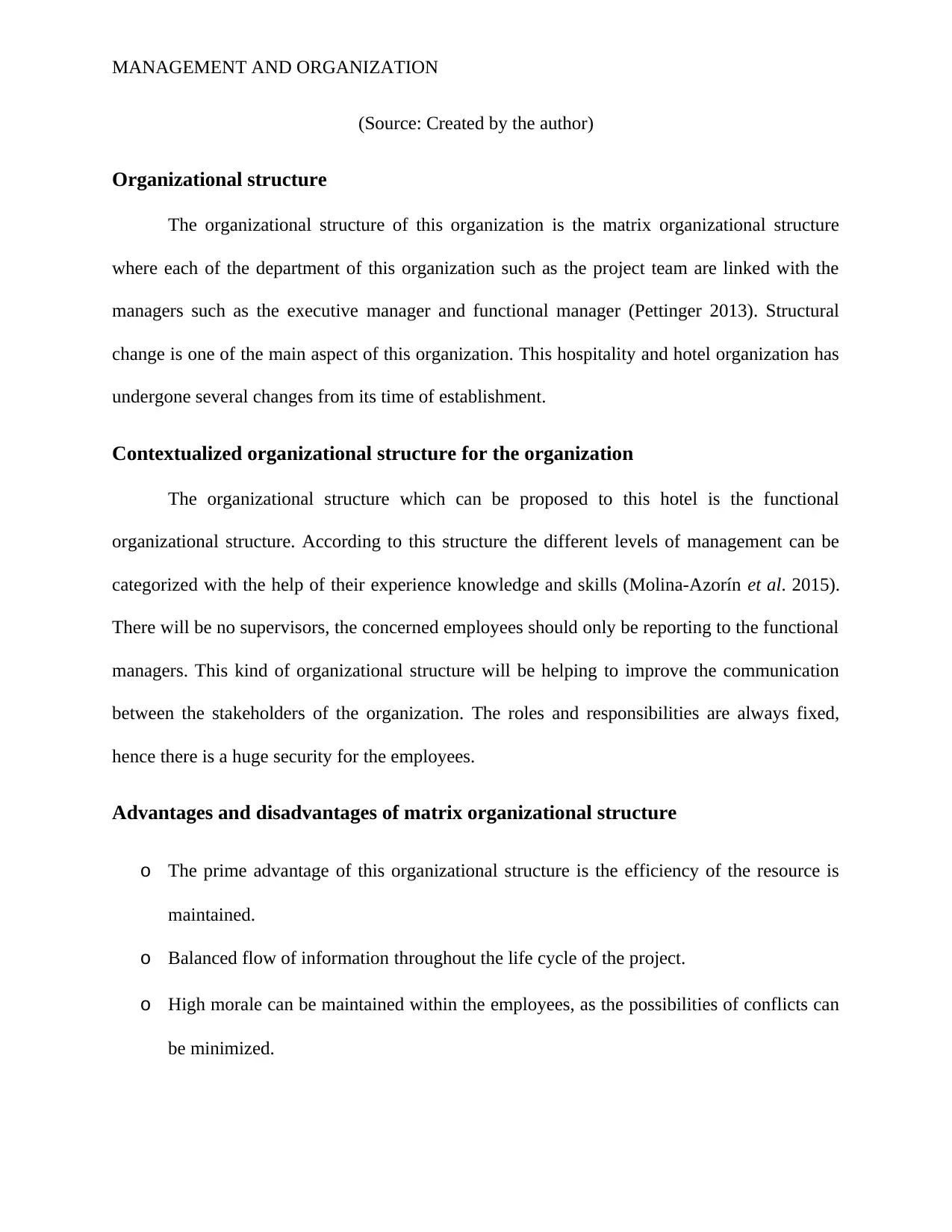
MANAGEMENT AND ORGANIZATION
(Source: Created by the author)
Organizational structure
The organizational structure of this organization is the matrix organizational structure
where each of the department of this organization such as the project team are linked with the
managers such as the executive manager and functional manager (Pettinger 2013). Structural
change is one of the main aspect of this organization. This hospitality and hotel organization has
undergone several changes from its time of establishment.
Contextualized organizational structure for the organization
The organizational structure which can be proposed to this hotel is the functional
organizational structure. According to this structure the different levels of management can be
categorized with the help of their experience knowledge and skills (Molina-Azorín et al. 2015).
There will be no supervisors, the concerned employees should only be reporting to the functional
managers. This kind of organizational structure will be helping to improve the communication
between the stakeholders of the organization. The roles and responsibilities are always fixed,
hence there is a huge security for the employees.
Advantages and disadvantages of matrix organizational structure
o The prime advantage of this organizational structure is the efficiency of the resource is
maintained.
o Balanced flow of information throughout the life cycle of the project.
o High morale can be maintained within the employees, as the possibilities of conflicts can
be minimized.
(Source: Created by the author)
Organizational structure
The organizational structure of this organization is the matrix organizational structure
where each of the department of this organization such as the project team are linked with the
managers such as the executive manager and functional manager (Pettinger 2013). Structural
change is one of the main aspect of this organization. This hospitality and hotel organization has
undergone several changes from its time of establishment.
Contextualized organizational structure for the organization
The organizational structure which can be proposed to this hotel is the functional
organizational structure. According to this structure the different levels of management can be
categorized with the help of their experience knowledge and skills (Molina-Azorín et al. 2015).
There will be no supervisors, the concerned employees should only be reporting to the functional
managers. This kind of organizational structure will be helping to improve the communication
between the stakeholders of the organization. The roles and responsibilities are always fixed,
hence there is a huge security for the employees.
Advantages and disadvantages of matrix organizational structure
o The prime advantage of this organizational structure is the efficiency of the resource is
maintained.
o Balanced flow of information throughout the life cycle of the project.
o High morale can be maintained within the employees, as the possibilities of conflicts can
be minimized.
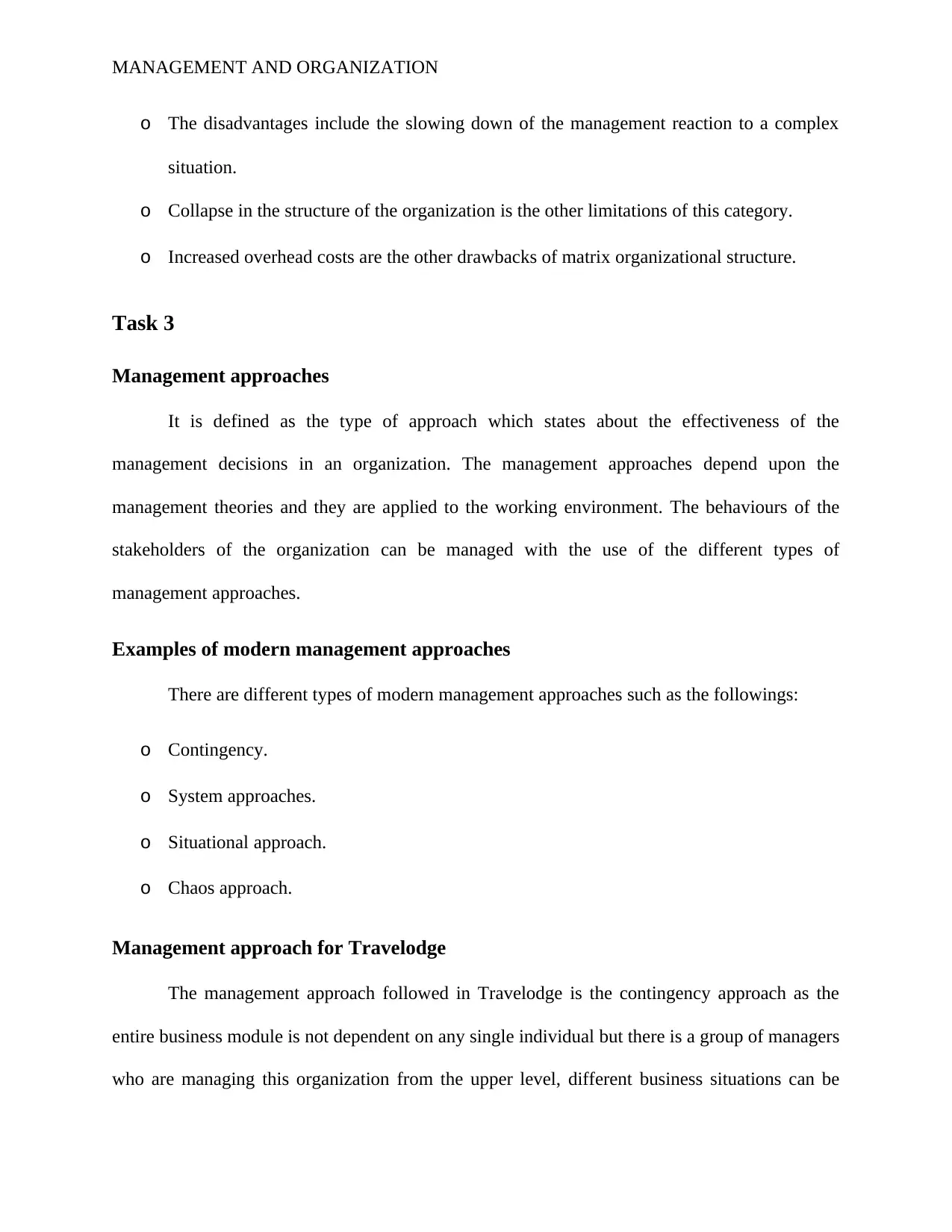
MANAGEMENT AND ORGANIZATION
o The disadvantages include the slowing down of the management reaction to a complex
situation.
o Collapse in the structure of the organization is the other limitations of this category.
o Increased overhead costs are the other drawbacks of matrix organizational structure.
Task 3
Management approaches
It is defined as the type of approach which states about the effectiveness of the
management decisions in an organization. The management approaches depend upon the
management theories and they are applied to the working environment. The behaviours of the
stakeholders of the organization can be managed with the use of the different types of
management approaches.
Examples of modern management approaches
There are different types of modern management approaches such as the followings:
o Contingency.
o System approaches.
o Situational approach.
o Chaos approach.
Management approach for Travelodge
The management approach followed in Travelodge is the contingency approach as the
entire business module is not dependent on any single individual but there is a group of managers
who are managing this organization from the upper level, different business situations can be
o The disadvantages include the slowing down of the management reaction to a complex
situation.
o Collapse in the structure of the organization is the other limitations of this category.
o Increased overhead costs are the other drawbacks of matrix organizational structure.
Task 3
Management approaches
It is defined as the type of approach which states about the effectiveness of the
management decisions in an organization. The management approaches depend upon the
management theories and they are applied to the working environment. The behaviours of the
stakeholders of the organization can be managed with the use of the different types of
management approaches.
Examples of modern management approaches
There are different types of modern management approaches such as the followings:
o Contingency.
o System approaches.
o Situational approach.
o Chaos approach.
Management approach for Travelodge
The management approach followed in Travelodge is the contingency approach as the
entire business module is not dependent on any single individual but there is a group of managers
who are managing this organization from the upper level, different business situations can be
⊘ This is a preview!⊘
Do you want full access?
Subscribe today to unlock all pages.

Trusted by 1+ million students worldwide

MANAGEMENT AND ORGANIZATION
managed with the help of this approach in Travelodge (Pettinger 2012). This type of
management practice is very much applicable for the having any kinds of changes within the
organization. The upgradation of the new rooms and other facilities are better managed with the
help of this management approach. Different ways of managing can be done with the help of this
category of management approach.
Advantage and disadvantage of contingency approach
Advantage Disadvantage
The main advantage of this approach is
the flexibility which is huge advantages
for this hotel industry.
The limitations associated with this type
of approach is that it’s a little bit time
consuming.
The growth of the employees is the other
advantage of this approach.
There are few complexities associated
with this approach such as the decision
making approaches of the functional
managers.
Effectiveness of this approach cannot be
always determined.
Table 1: Advantage and disadvantage of contingency approach
(Source: Created by the author)
managed with the help of this approach in Travelodge (Pettinger 2012). This type of
management practice is very much applicable for the having any kinds of changes within the
organization. The upgradation of the new rooms and other facilities are better managed with the
help of this management approach. Different ways of managing can be done with the help of this
category of management approach.
Advantage and disadvantage of contingency approach
Advantage Disadvantage
The main advantage of this approach is
the flexibility which is huge advantages
for this hotel industry.
The limitations associated with this type
of approach is that it’s a little bit time
consuming.
The growth of the employees is the other
advantage of this approach.
There are few complexities associated
with this approach such as the decision
making approaches of the functional
managers.
Effectiveness of this approach cannot be
always determined.
Table 1: Advantage and disadvantage of contingency approach
(Source: Created by the author)
Paraphrase This Document
Need a fresh take? Get an instant paraphrase of this document with our AI Paraphraser
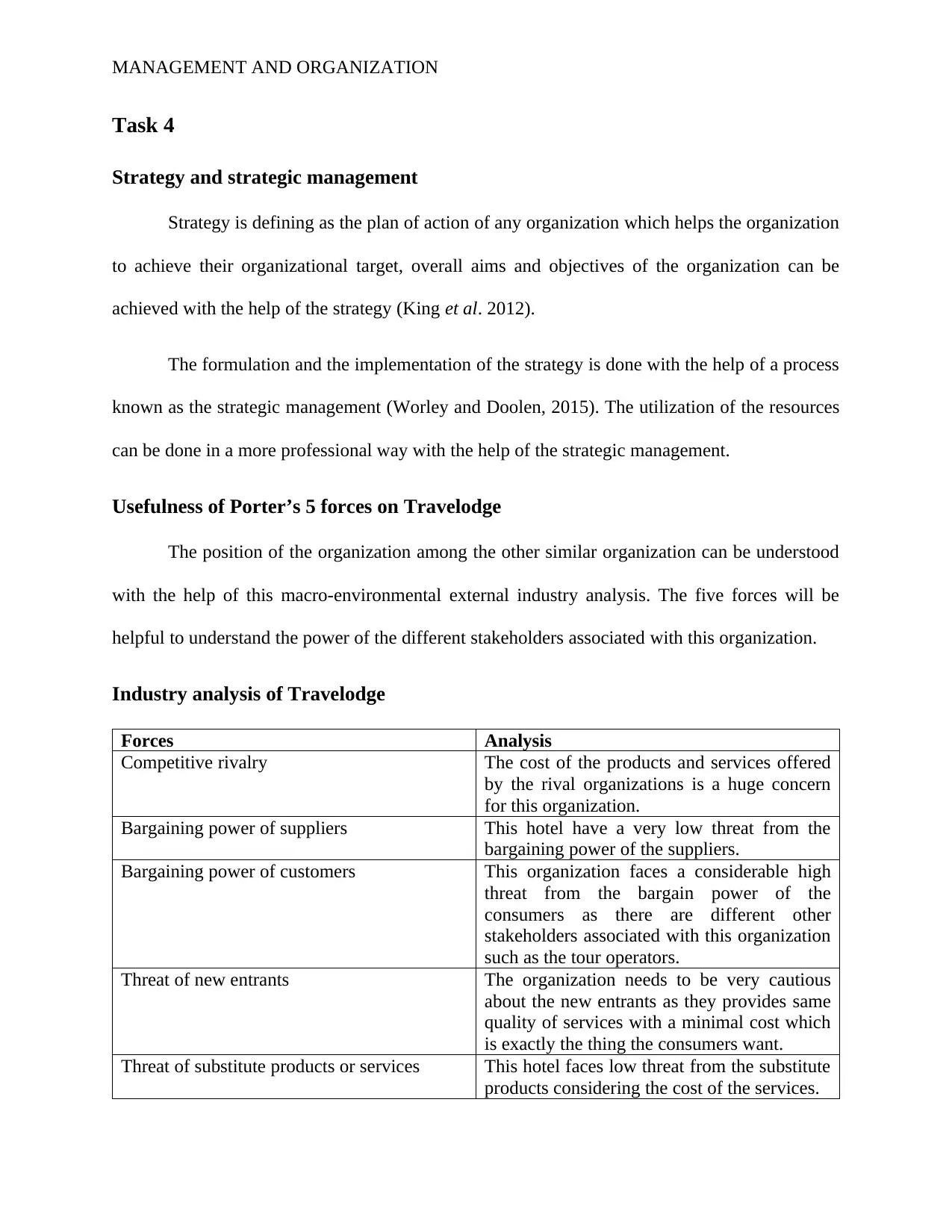
MANAGEMENT AND ORGANIZATION
Task 4
Strategy and strategic management
Strategy is defining as the plan of action of any organization which helps the organization
to achieve their organizational target, overall aims and objectives of the organization can be
achieved with the help of the strategy (King et al. 2012).
The formulation and the implementation of the strategy is done with the help of a process
known as the strategic management (Worley and Doolen, 2015). The utilization of the resources
can be done in a more professional way with the help of the strategic management.
Usefulness of Porter’s 5 forces on Travelodge
The position of the organization among the other similar organization can be understood
with the help of this macro-environmental external industry analysis. The five forces will be
helpful to understand the power of the different stakeholders associated with this organization.
Industry analysis of Travelodge
Forces Analysis
Competitive rivalry The cost of the products and services offered
by the rival organizations is a huge concern
for this organization.
Bargaining power of suppliers This hotel have a very low threat from the
bargaining power of the suppliers.
Bargaining power of customers This organization faces a considerable high
threat from the bargain power of the
consumers as there are different other
stakeholders associated with this organization
such as the tour operators.
Threat of new entrants The organization needs to be very cautious
about the new entrants as they provides same
quality of services with a minimal cost which
is exactly the thing the consumers want.
Threat of substitute products or services This hotel faces low threat from the substitute
products considering the cost of the services.
Task 4
Strategy and strategic management
Strategy is defining as the plan of action of any organization which helps the organization
to achieve their organizational target, overall aims and objectives of the organization can be
achieved with the help of the strategy (King et al. 2012).
The formulation and the implementation of the strategy is done with the help of a process
known as the strategic management (Worley and Doolen, 2015). The utilization of the resources
can be done in a more professional way with the help of the strategic management.
Usefulness of Porter’s 5 forces on Travelodge
The position of the organization among the other similar organization can be understood
with the help of this macro-environmental external industry analysis. The five forces will be
helpful to understand the power of the different stakeholders associated with this organization.
Industry analysis of Travelodge
Forces Analysis
Competitive rivalry The cost of the products and services offered
by the rival organizations is a huge concern
for this organization.
Bargaining power of suppliers This hotel have a very low threat from the
bargaining power of the suppliers.
Bargaining power of customers This organization faces a considerable high
threat from the bargain power of the
consumers as there are different other
stakeholders associated with this organization
such as the tour operators.
Threat of new entrants The organization needs to be very cautious
about the new entrants as they provides same
quality of services with a minimal cost which
is exactly the thing the consumers want.
Threat of substitute products or services This hotel faces low threat from the substitute
products considering the cost of the services.
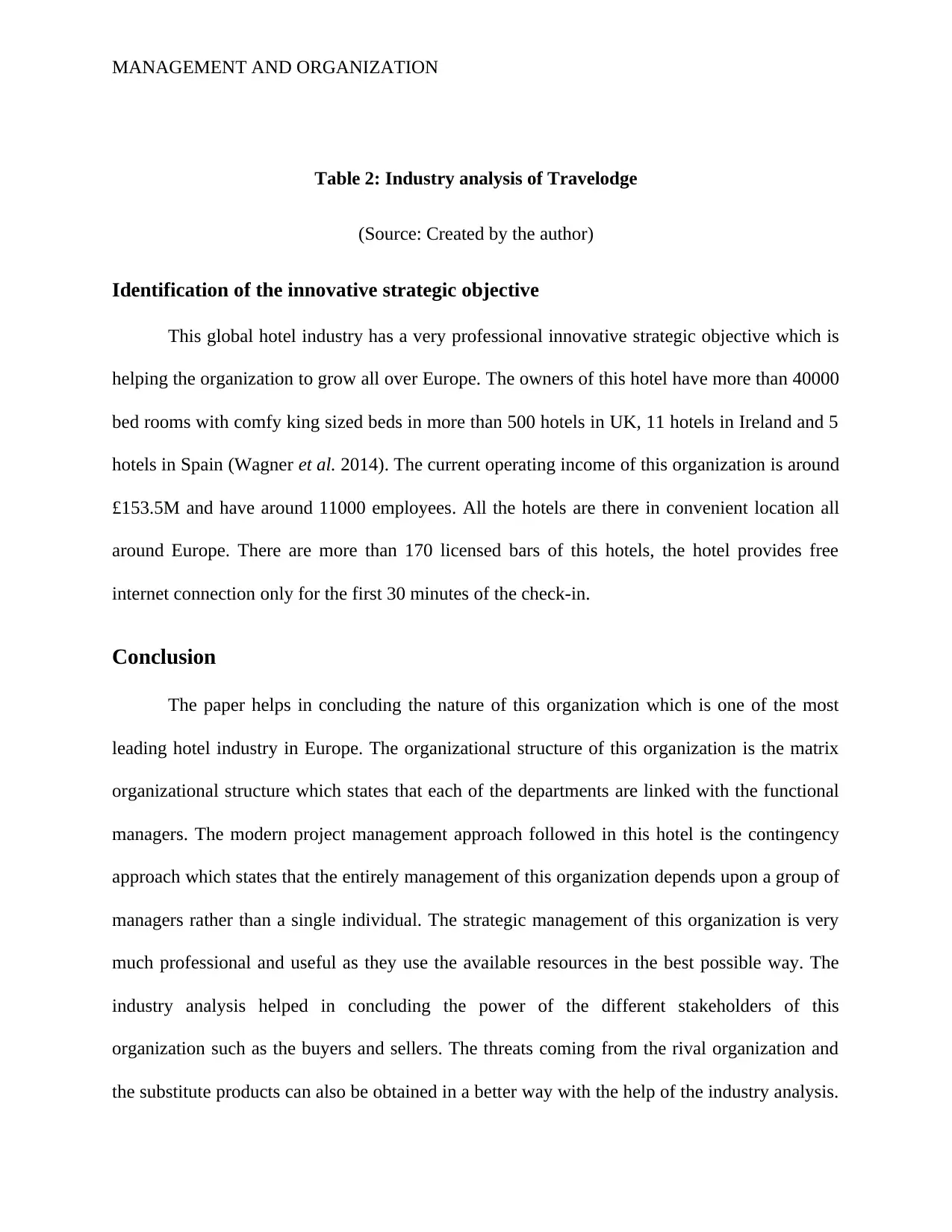
MANAGEMENT AND ORGANIZATION
Table 2: Industry analysis of Travelodge
(Source: Created by the author)
Identification of the innovative strategic objective
This global hotel industry has a very professional innovative strategic objective which is
helping the organization to grow all over Europe. The owners of this hotel have more than 40000
bed rooms with comfy king sized beds in more than 500 hotels in UK, 11 hotels in Ireland and 5
hotels in Spain (Wagner et al. 2014). The current operating income of this organization is around
£153.5M and have around 11000 employees. All the hotels are there in convenient location all
around Europe. There are more than 170 licensed bars of this hotels, the hotel provides free
internet connection only for the first 30 minutes of the check-in.
Conclusion
The paper helps in concluding the nature of this organization which is one of the most
leading hotel industry in Europe. The organizational structure of this organization is the matrix
organizational structure which states that each of the departments are linked with the functional
managers. The modern project management approach followed in this hotel is the contingency
approach which states that the entirely management of this organization depends upon a group of
managers rather than a single individual. The strategic management of this organization is very
much professional and useful as they use the available resources in the best possible way. The
industry analysis helped in concluding the power of the different stakeholders of this
organization such as the buyers and sellers. The threats coming from the rival organization and
the substitute products can also be obtained in a better way with the help of the industry analysis.
Table 2: Industry analysis of Travelodge
(Source: Created by the author)
Identification of the innovative strategic objective
This global hotel industry has a very professional innovative strategic objective which is
helping the organization to grow all over Europe. The owners of this hotel have more than 40000
bed rooms with comfy king sized beds in more than 500 hotels in UK, 11 hotels in Ireland and 5
hotels in Spain (Wagner et al. 2014). The current operating income of this organization is around
£153.5M and have around 11000 employees. All the hotels are there in convenient location all
around Europe. There are more than 170 licensed bars of this hotels, the hotel provides free
internet connection only for the first 30 minutes of the check-in.
Conclusion
The paper helps in concluding the nature of this organization which is one of the most
leading hotel industry in Europe. The organizational structure of this organization is the matrix
organizational structure which states that each of the departments are linked with the functional
managers. The modern project management approach followed in this hotel is the contingency
approach which states that the entirely management of this organization depends upon a group of
managers rather than a single individual. The strategic management of this organization is very
much professional and useful as they use the available resources in the best possible way. The
industry analysis helped in concluding the power of the different stakeholders of this
organization such as the buyers and sellers. The threats coming from the rival organization and
the substitute products can also be obtained in a better way with the help of the industry analysis.
⊘ This is a preview!⊘
Do you want full access?
Subscribe today to unlock all pages.

Trusted by 1+ million students worldwide

MANAGEMENT AND ORGANIZATION
The impact of the forces which this organization faces towards the growth and development is
stated in the paper.
The impact of the forces which this organization faces towards the growth and development is
stated in the paper.
Paraphrase This Document
Need a fresh take? Get an instant paraphrase of this document with our AI Paraphraser
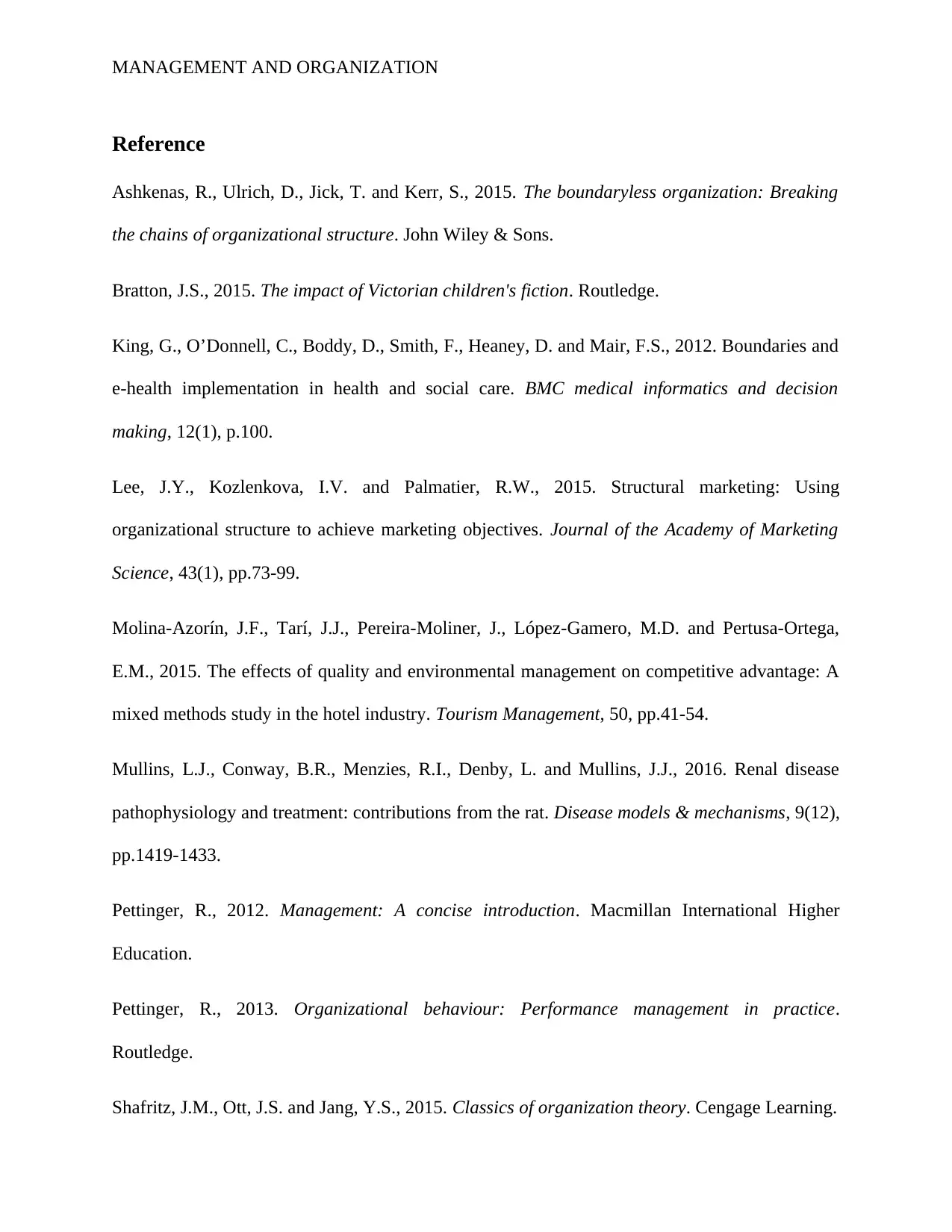
MANAGEMENT AND ORGANIZATION
Reference
Ashkenas, R., Ulrich, D., Jick, T. and Kerr, S., 2015. The boundaryless organization: Breaking
the chains of organizational structure. John Wiley & Sons.
Bratton, J.S., 2015. The impact of Victorian children's fiction. Routledge.
King, G., O’Donnell, C., Boddy, D., Smith, F., Heaney, D. and Mair, F.S., 2012. Boundaries and
e-health implementation in health and social care. BMC medical informatics and decision
making, 12(1), p.100.
Lee, J.Y., Kozlenkova, I.V. and Palmatier, R.W., 2015. Structural marketing: Using
organizational structure to achieve marketing objectives. Journal of the Academy of Marketing
Science, 43(1), pp.73-99.
Molina-Azorín, J.F., Tarí, J.J., Pereira-Moliner, J., López-Gamero, M.D. and Pertusa-Ortega,
E.M., 2015. The effects of quality and environmental management on competitive advantage: A
mixed methods study in the hotel industry. Tourism Management, 50, pp.41-54.
Mullins, L.J., Conway, B.R., Menzies, R.I., Denby, L. and Mullins, J.J., 2016. Renal disease
pathophysiology and treatment: contributions from the rat. Disease models & mechanisms, 9(12),
pp.1419-1433.
Pettinger, R., 2012. Management: A concise introduction. Macmillan International Higher
Education.
Pettinger, R., 2013. Organizational behaviour: Performance management in practice.
Routledge.
Shafritz, J.M., Ott, J.S. and Jang, Y.S., 2015. Classics of organization theory. Cengage Learning.
Reference
Ashkenas, R., Ulrich, D., Jick, T. and Kerr, S., 2015. The boundaryless organization: Breaking
the chains of organizational structure. John Wiley & Sons.
Bratton, J.S., 2015. The impact of Victorian children's fiction. Routledge.
King, G., O’Donnell, C., Boddy, D., Smith, F., Heaney, D. and Mair, F.S., 2012. Boundaries and
e-health implementation in health and social care. BMC medical informatics and decision
making, 12(1), p.100.
Lee, J.Y., Kozlenkova, I.V. and Palmatier, R.W., 2015. Structural marketing: Using
organizational structure to achieve marketing objectives. Journal of the Academy of Marketing
Science, 43(1), pp.73-99.
Molina-Azorín, J.F., Tarí, J.J., Pereira-Moliner, J., López-Gamero, M.D. and Pertusa-Ortega,
E.M., 2015. The effects of quality and environmental management on competitive advantage: A
mixed methods study in the hotel industry. Tourism Management, 50, pp.41-54.
Mullins, L.J., Conway, B.R., Menzies, R.I., Denby, L. and Mullins, J.J., 2016. Renal disease
pathophysiology and treatment: contributions from the rat. Disease models & mechanisms, 9(12),
pp.1419-1433.
Pettinger, R., 2012. Management: A concise introduction. Macmillan International Higher
Education.
Pettinger, R., 2013. Organizational behaviour: Performance management in practice.
Routledge.
Shafritz, J.M., Ott, J.S. and Jang, Y.S., 2015. Classics of organization theory. Cengage Learning.
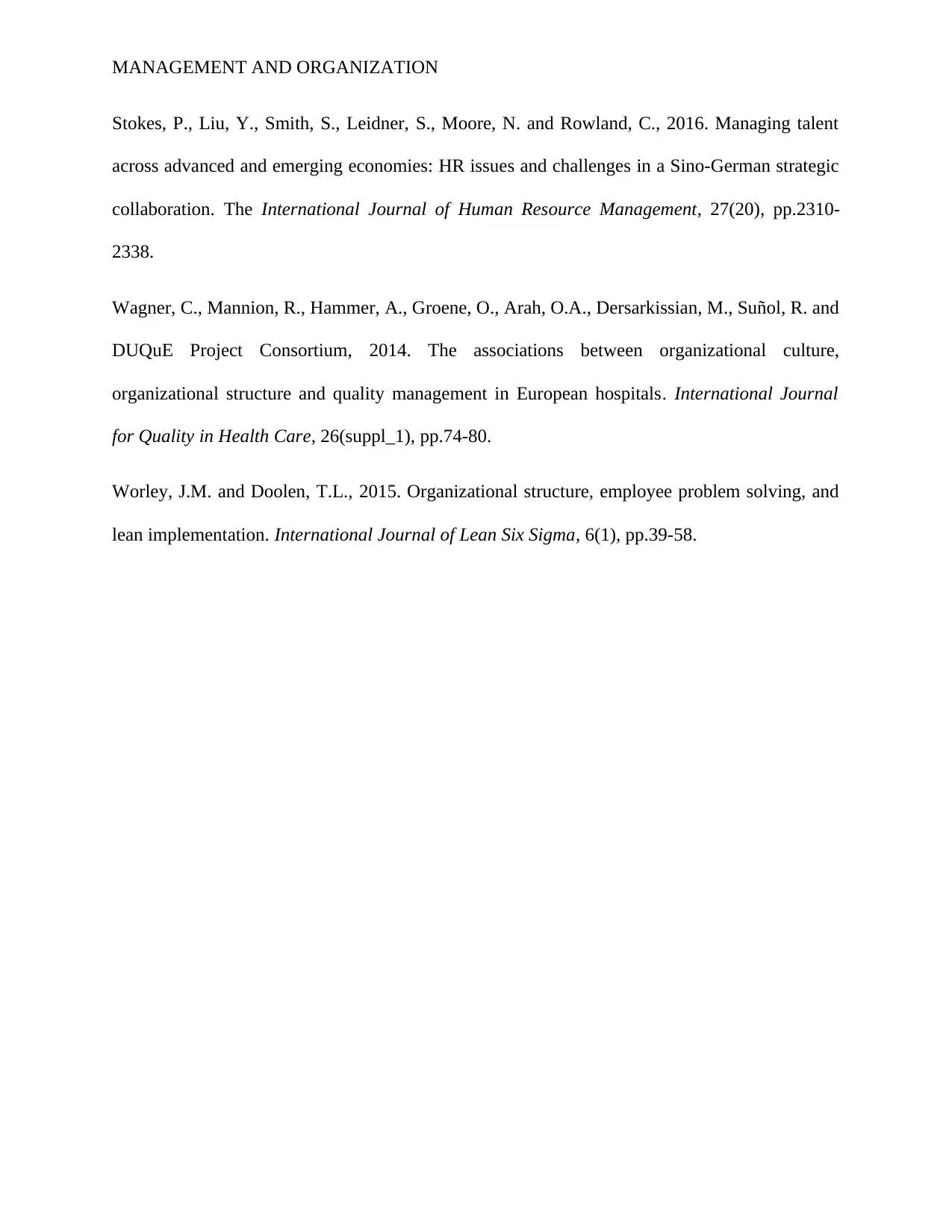
MANAGEMENT AND ORGANIZATION
Stokes, P., Liu, Y., Smith, S., Leidner, S., Moore, N. and Rowland, C., 2016. Managing talent
across advanced and emerging economies: HR issues and challenges in a Sino-German strategic
collaboration. The International Journal of Human Resource Management, 27(20), pp.2310-
2338.
Wagner, C., Mannion, R., Hammer, A., Groene, O., Arah, O.A., Dersarkissian, M., Suñol, R. and
DUQuE Project Consortium, 2014. The associations between organizational culture,
organizational structure and quality management in European hospitals. International Journal
for Quality in Health Care, 26(suppl_1), pp.74-80.
Worley, J.M. and Doolen, T.L., 2015. Organizational structure, employee problem solving, and
lean implementation. International Journal of Lean Six Sigma, 6(1), pp.39-58.
Stokes, P., Liu, Y., Smith, S., Leidner, S., Moore, N. and Rowland, C., 2016. Managing talent
across advanced and emerging economies: HR issues and challenges in a Sino-German strategic
collaboration. The International Journal of Human Resource Management, 27(20), pp.2310-
2338.
Wagner, C., Mannion, R., Hammer, A., Groene, O., Arah, O.A., Dersarkissian, M., Suñol, R. and
DUQuE Project Consortium, 2014. The associations between organizational culture,
organizational structure and quality management in European hospitals. International Journal
for Quality in Health Care, 26(suppl_1), pp.74-80.
Worley, J.M. and Doolen, T.L., 2015. Organizational structure, employee problem solving, and
lean implementation. International Journal of Lean Six Sigma, 6(1), pp.39-58.
⊘ This is a preview!⊘
Do you want full access?
Subscribe today to unlock all pages.

Trusted by 1+ million students worldwide
1 out of 12
Related Documents
Your All-in-One AI-Powered Toolkit for Academic Success.
+13062052269
info@desklib.com
Available 24*7 on WhatsApp / Email
![[object Object]](/_next/static/media/star-bottom.7253800d.svg)
Unlock your academic potential
Copyright © 2020–2025 A2Z Services. All Rights Reserved. Developed and managed by ZUCOL.





